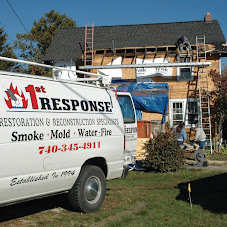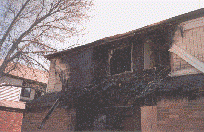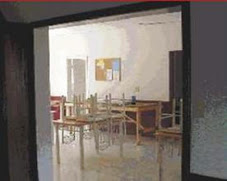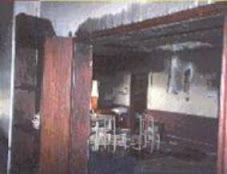INSIDE
CLEAN CARPETS as soon as the spring mud season is over. Vacuum them thoroughly, then shampoo with a spray foam or powder or rent a steamer from a hardware store for an even deeper clean.
CLEAN AND VENTILATE THE BASEMENT. Open windows and give your cellar a good airing, then sweep the area thoroughly or vacuum.
START UP YOUR DEHUMIDIFIER. Clean it, make sure that it's in working order, then run it in a humid basement or partially underground room. Dampness during spring and summer months causes mildew.
OUTSIDE
IF YOU HAVE A SWIMMING POOL, ensure that cleaning equipment is in good shape and your water-testing kit is complete. Stock up on chemicals. If you lowered the water level in the fall, fill the pool now.
PUT UP WINDOW BOXES. Dump out old soil and clean the boxes thoroughly. Line wooden boxes with garbage bags to protect them from moisture. Make sure there are drainage holes. Replant with potting soil.
INSTALL WINDOW-UNIT AIR CONDITIONERS. Carefully go over the unit with the brush attachment of your vacuum. Remove and wash the filter and let it dry completely, then reinstall it.
FERTILIZE YOUR LAWN A high-nitrogen fertilizer should be applied twice a year, once in spring and again later in fall. If a weed killer is needed, try an organic brand.
1st Response
Restoration and Reconstruction Specialists
Water - Fire - Smoke - Mold
Thursday, March 18, 2010
Tuesday, March 16, 2010
Getting Rid of Water Damage
If your home is ravaged by water damage, here are some things you can do to fix the situation.
•Find the source of the water and fix it. Most often, water damage comes from leaks from pipes or drainage. Get yourself one of those cement glues specifically made for covering up leaky pipes and you should do fine. Remember to turn off your water source first before trying to find and fix the leak.
•Get rid of any excess water. You can do this by simply mopping the entire wet area. If mops don't work, then try using a vacuum cleaner. Do this as quickly as possible. The faster you can clean the water up, the less likely it is mold and mildew will develop. If the water damage is particularly large, take pictures of the damage prior to cleaning it up for the insurance company to cover.
•Let in proper ventilation or turn up the air conditioner. Doing so will prevent the growth of molds and mildew. Proper ventilation will also cause cloth or cloth-like fibers to dry faster if the water damage has affected them.
•Call in the professionals. The best way to get rid of water damage is to hire professional cleaners. They will assure that your home and furniture will be handled with the utmost care.
Water damage to your house should never be taken lightly. Your house is one of your biggest investments. You should take care of it so it will remain standing, clean, and intact.
•Find the source of the water and fix it. Most often, water damage comes from leaks from pipes or drainage. Get yourself one of those cement glues specifically made for covering up leaky pipes and you should do fine. Remember to turn off your water source first before trying to find and fix the leak.
•Get rid of any excess water. You can do this by simply mopping the entire wet area. If mops don't work, then try using a vacuum cleaner. Do this as quickly as possible. The faster you can clean the water up, the less likely it is mold and mildew will develop. If the water damage is particularly large, take pictures of the damage prior to cleaning it up for the insurance company to cover.
•Let in proper ventilation or turn up the air conditioner. Doing so will prevent the growth of molds and mildew. Proper ventilation will also cause cloth or cloth-like fibers to dry faster if the water damage has affected them.
•Call in the professionals. The best way to get rid of water damage is to hire professional cleaners. They will assure that your home and furniture will be handled with the utmost care.
Water damage to your house should never be taken lightly. Your house is one of your biggest investments. You should take care of it so it will remain standing, clean, and intact.
Labels:
1st-response,
Knox,
licking county,
muskingum county,
perry county
Signs of Water Damage
Does your house have any water damage?
Check for these warning signs right away so you can identify and stop the problem before it gets worse.
•Standing water on the floor. The most obvious sign of impending water damage are pools of water on the floor, most usually in the kitchen. These pools of water indicate that there's a continuous leak somewhere and it has been escaping the normal process of evaporation. If you've already mopped up standing water on your floor and then find some again the next couple of days, then put the mop aside and start looking for leaks or drips. You can mop all you want but as long as you don't fix the source, you will always end up doing the same thing. Your floor will also get damaged day after day.
•Indicators in the house's structure. If your floor begins to buckle slightly, then water is probably present. The reason for this is that vinyl floors are laid over particleboard underlayment that absorbs water and then swells up. If you have hardwood floors, water cups up around the tongue-and-groove joints.
The most common area where water damage is seen is the bathroom in front of the tub or shower --- the damage can occur from splashing or where people step in and out with dripping feet. Keep an eye out for any buckling.
For drywall, check for a discolored or slightly swollen appearance since drywall softens and breaks down.
•Appearance of stains. Next to standing water, the appearance of stains in several parts of your house is a good indication that you have a leak or water encroachment somewhere. The stains may appear:
•Around the windows or on the bottom of the exterior doors, indicating that the water is coming from the outside;
•At the joint between the exterior wall and the ceiling --- it can also mean an ice-damming problem;
•Anywhere in the ceiling, which is almost an indication of a roof leak, unless you have installed water lines in your attic. If you see stains on your ceiling, remember that it does not mean the leak is right above it. Usually, it originates higher and just drips down.
•In cabinets that house a sink --- an indication of a leak in the sink drain system or from the trap.
•Where there are mildew and mold stains. While not exactly definitive proof of a leak, the presence of mildew or molds indicates moisture. In a bathroom where moisture is prevalent, it's an indication that you just don't have enough ventilation to rid the room of mildew. If you see them at the bottom of an exterior wall, it might mean that water is coming in. In closets or places where there is little or no air circulation present, it could mean an overly damp crawl space.
Check for these warning signs right away so you can identify and stop the problem before it gets worse.
•Standing water on the floor. The most obvious sign of impending water damage are pools of water on the floor, most usually in the kitchen. These pools of water indicate that there's a continuous leak somewhere and it has been escaping the normal process of evaporation. If you've already mopped up standing water on your floor and then find some again the next couple of days, then put the mop aside and start looking for leaks or drips. You can mop all you want but as long as you don't fix the source, you will always end up doing the same thing. Your floor will also get damaged day after day.
•Indicators in the house's structure. If your floor begins to buckle slightly, then water is probably present. The reason for this is that vinyl floors are laid over particleboard underlayment that absorbs water and then swells up. If you have hardwood floors, water cups up around the tongue-and-groove joints.
The most common area where water damage is seen is the bathroom in front of the tub or shower --- the damage can occur from splashing or where people step in and out with dripping feet. Keep an eye out for any buckling.
For drywall, check for a discolored or slightly swollen appearance since drywall softens and breaks down.
•Appearance of stains. Next to standing water, the appearance of stains in several parts of your house is a good indication that you have a leak or water encroachment somewhere. The stains may appear:
•Around the windows or on the bottom of the exterior doors, indicating that the water is coming from the outside;
•At the joint between the exterior wall and the ceiling --- it can also mean an ice-damming problem;
•Anywhere in the ceiling, which is almost an indication of a roof leak, unless you have installed water lines in your attic. If you see stains on your ceiling, remember that it does not mean the leak is right above it. Usually, it originates higher and just drips down.
•In cabinets that house a sink --- an indication of a leak in the sink drain system or from the trap.
•Where there are mildew and mold stains. While not exactly definitive proof of a leak, the presence of mildew or molds indicates moisture. In a bathroom where moisture is prevalent, it's an indication that you just don't have enough ventilation to rid the room of mildew. If you see them at the bottom of an exterior wall, it might mean that water is coming in. In closets or places where there is little or no air circulation present, it could mean an overly damp crawl space.
Labels:
1st response,
damage,
ice buildup on a roof,
water
Subscribe to:
Posts (Atom)












